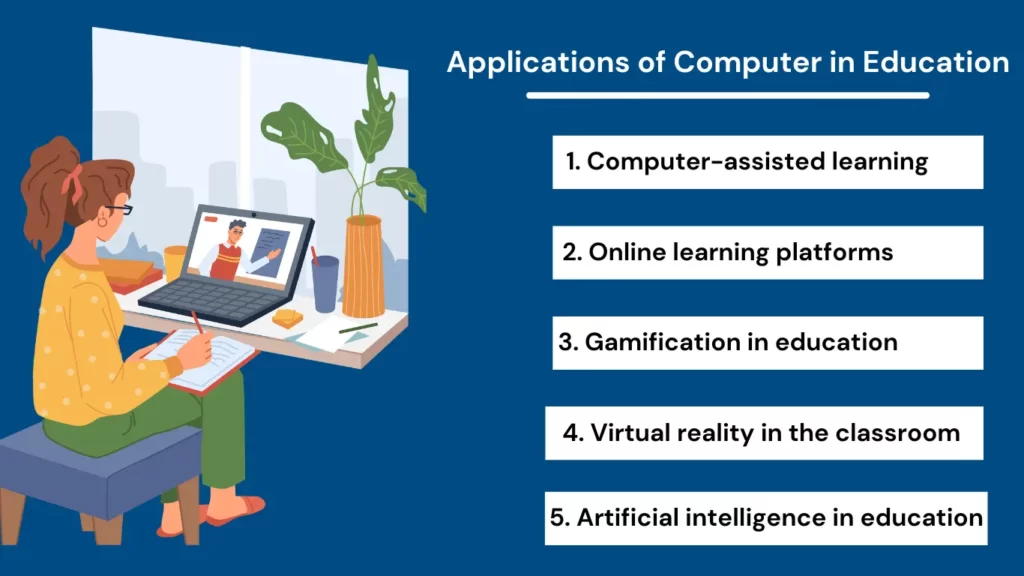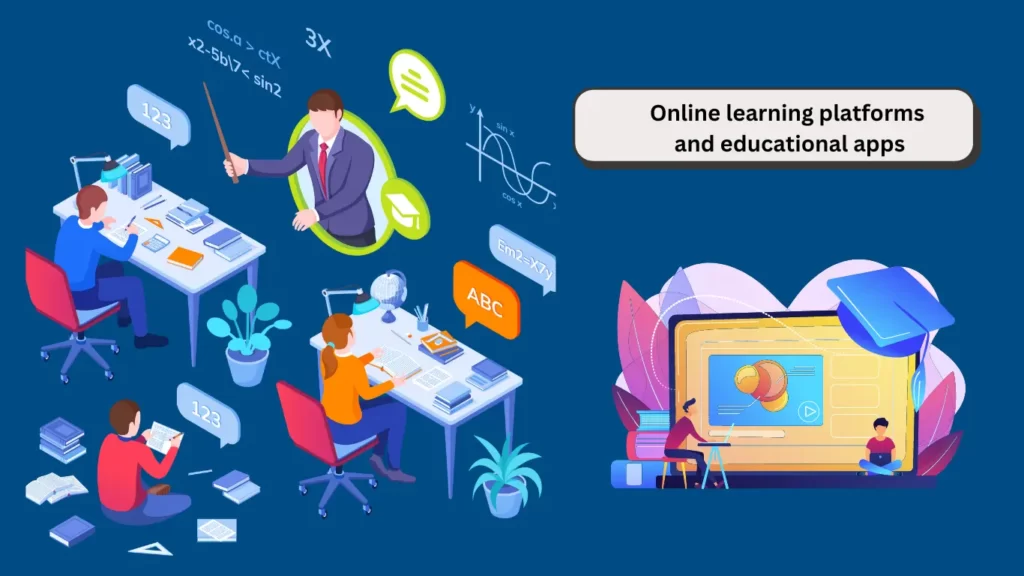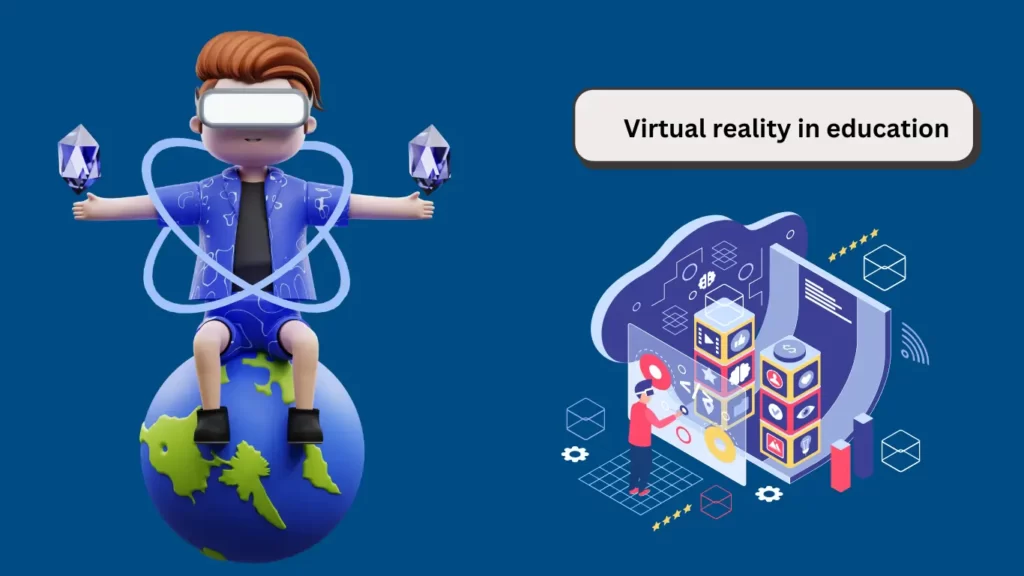Applications of Computer in Education : In today’s rapidly evolving digital age, computers have become an integral part of our lives. They have revolutionized various industries, including education. The applications of computers in education are diverse and have the potential to enhance learning experiences for students of all ages.

From computer-assisted learning to artificial intelligence, this article will delve into Applications of Computer in Education.
Applications of Computer in Education
1. Computer-assisted learning
Computer-assisted learning has emerged as a powerful tool in education. It involves the use of computers to supplement traditional teaching methods and deliver personalized learning experiences. With the help of educational software, students can engage in interactive lessons, practice quizzes, and simulations that cater to their individual needs.
One of the key advantages of computer-assisted learning is its ability to provide immediate feedback. Students can receive instant evaluation and analysis of their performance, allowing them to identify areas of improvement and work towards achieving mastery. Moreover, the use of multimedia elements, such as videos and animations, makes the learning process more engaging and enjoyable.
2. Online learning platforms and educational apps
The rise of online learning platforms and educational apps has transformed the way students access educational content. These platforms offer a wide range of courses and resources that can be accessed from anywhere, at any time. Whether it’s a video lecture, an interactive quiz, or an e-book, students can conveniently learn at their own pace.

Educational apps, on the other hand, provide students with interactive and engaging content that complements their classroom learning. From language learning to math games, these apps make learning fun and accessible. With the convenience of smartphones and tablets, students can engage with educational content on the go, making learning a part of their daily lives.
3. Gamification in education
Gamification has gained significant traction in the field of education. By incorporating game elements into the learning process, educators can create a more immersive and engaging experience for students. Gamified learning platforms often include elements such as points, leader boards, badges, and rewards, which motivate students to actively participate and excel in their studies.
Games provide a safe and stimulating environment where students can experiment, make decisions, and learn from their mistakes. They foster critical thinking, problem-solving, and collaboration skills, which are essential for success in the digital age.
4. Virtual reality in the classroom
Virtual reality (VR) is a cutting-edge technology that is revolutionizing education. By immersing students in virtual environments, VR offers a unique and experiential learning experience. Whether it’s exploring ancient civilizations, conducting virtual science experiments, or visiting historical landmarks, VR transports students to places they could only dream of.
VR stimulates multiple senses and enhances spatial awareness, making learning more memorable and impact. It helps students visualize complex concepts and develop a deeper understanding of the subject matter. Additionally, VR can be used to create inclusive learning experiences, enabling students with physical disabilities to explore and interact with the world in ways that were previously unimaginable.
5. Artificial intelligence in education
Artificial intelligence (AI) has the potential to revolutionize education by providing personalized learning experiences. AI algorithms can analyze vast amounts of data, including students’ performance, learning preferences, and progress, to create tailored learning paths. This ensures that each student receives individualized instruction and support, maximizing their learning outcomes.
Moreover, AI can streamline administrative tasks, freeing up valuable time for educators to focus on instruction. From grading assignments to generating personalized feedback, AI systems can automate time-consuming processes, allowing teachers to devote more attention to their students’ needs.
6. Data analytics and personalized learning
Data analytics plays a crucial role in personalized learning. By analyzing student data, such as performance metrics, learning patterns, and engagement levels, educators can gain valuable insights into each student’s strengths and weaknesses. This data-driven approach enables teachers to tailor instruction to meet the unique needs of each student, maximizing their learning potential.
Personalized learning ensures that students receive the right content, at the right time, and in the right format. It allows them to progress at their own pace, ensuring a deeper understanding of the subject matter. Moreover, personalized learning fosters student autonomy and self-regulation, as they take ownership of their learning journey.
7. Virtual reality in education
Virtual reality (VR) is a cutting-edge technology that is revolutionizing education. By immersing students in virtual environments, VR offers a unique and experiential learning experience. Whether it’s exploring ancient civilizations, conducting virtual science experiments, or visiting historical landmarks, VR transports students to places they could only dream of.

VR stimulates multiple senses and enhances spatial awareness, making learning more memorable and impact. It helps students visualize complex concepts and develop a deeper understanding of the subject matter. Additionally, VR can be used to create inclusive learning experiences, enabling students with physical disabilities to explore and interact with the world in ways that were previously unimaginable.
Conclusion : Applications of Computer in Education
The applications of computers in education are vast and diverse. From computer-assisted learning to virtual reality, artificial intelligence, and data analytics, computers have revolutionized the way we learn. They have enhanced the learning experience, making it more personalized, engaging, and accessible.
As we continue to harness the power of the digital age, it is crucial that we embrace these technologies and leverage them to create meaningful educational experiences. By embracing the diverse applications of computers in education, we can empower students to thrive in the digital world and equip them with the skills they need to succeed in the future.
Pingback: TOP 8 Application of Computer in Pharmacy - EASY NOTES